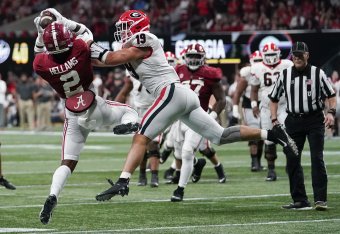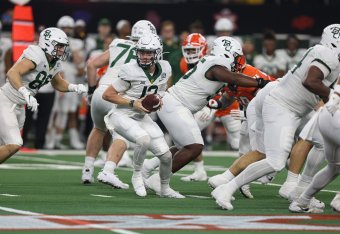Featured Video
How 'Tush Push' Survived 🗳️

Did the College Football Playoff Committee Get It Right?
The 2021 College Football Playoff field was revealed Sunday afternoon. On New Year's Eve, No. 1 Alabama and No. 4 Cincinnati will play in the Cotton Bowl semifinal, and No. 2 Michigan and No. 3 Georgia will play in the Orange Bowl semifinal.
As is the case pretty much every year, the lingering question is Did the committee get it right? The answer is a bit more clear than in years past, but that doesn't mean there's ever a definitive "yes" or "no."
First, let's run through some aspects of the criteria that the selection committee uses to determine which four teams make it in: "Establish a committee that will be instructed to place an emphasis on winning conference championships, strength of schedule and head‐to‐head competition when comparing teams with similar records and pedigree."
TOP NEWS

Projecting Top D-Lines for the 2025 CFB Season

Under-the-Radar Impact Transfers for the 2025 College Football Season

Alabama's Keelon Russell Gifts Mom New Mercedes-Benz Ahead of Freshman Season
And further, when certain teams have similar resumes, the committee considers:
Championships won
Strength of schedule
Head‐to‐head competition (if it occurred)
Comparative outcomes of common opponents (without incenting margin of victory)
The other feature the committee has—and perhaps one of the reasons it's more unique than the BCS—is that the committee is human. It's made up of 13 individuals, some of whom are current and former athletic directors, coaches and players who have an understanding of the sport and what makes teams stand out. So there is a human "eye test" that goes into evaluating these teams as well.
Now let's bring the scene back to where things stood heading into championship Saturday. If Alabama were to lose a close game to Georgia, there was a scenario that a two-loss Crimson Tide could make it in. A Georgia loss to Bama wouldn't be catastrophic enough to keep the Dawgs out, given how dominant they've looked all year.
Cincinnati just needed to beat Houston in the AAC Championship Game and finish undefeated to get in. In the Big 12, Oklahoma State could make it in with a conference title-game victory over No. 9 Baylor to make it in as a one-loss conference champion. No. 2 Michigan needed to take care of No. 13 Iowa in the Big Ten title game, and the Wolverines would be in.

The remaining one-loss team that had a shot was Notre Dame, which lost to Cincy earlier in the season. The Fighting Irish likely needed the Bearcats to fall to Houston, along with Alabama or Michigan losing as well.
Early on championship Saturday, it looked as if the chaos Notre Dame needed to make it in might happen. OK State lost to Baylor 21-6. The Cowboys had an impressive second-half comeback against No. 10 Oklahoma just one week ago looked like a completely different team against the Bears defense Saturday.
OK State quarterback Spencer Sanders threw a career-high four interceptions, and OK State went to the locker room down 21-6. The Cowboys offense struggled—its lone touchdown of the day came with 7:09 left in the third.
With the game on the line, the Pokes made it all the way down to Baylor's 1-yard line, but on 4th-and-1, running back Dezmon Jackson was stopped just short of the pylon to give the Bears the win.
Was there a shot for a two-loss Baylor Big 12 champion to make it in over Notre Dame? Maybe—per The Action Network's Brett McMurphy, the Bears' actually had a stronger resume.
Baylor had Top 25 wins over Iowa State, BYU and Oklahoma. Notre Dame had one, over Wisconsin, plus the Bears had more wins over winning teams with a 6-4 record, and they played in and won a conference title game while the independent Irish sat at home.

Regardless, Notre Dame watched and hoped the chaos trend would continue throughout the day, as it was all it could do. But Alabama and Cincinnati (and ultimately, Michigan) dashed any hopes of a Fighting Irish playoff bid.
What the Tide did Saturday to Georgia was, well, remarkably impressive. So impressive, in fact, that the committee moved the Tide into the No. 1 spot. There were plenty of questions surrounding this Tide team all season. Coming into the year, it had to replace quarterback Mac Jones, running back Najee Harris and receivers Jaylen Waddle and Heisman Trophy winner DeVonta Smith.
During the season, Bama didn't look like the juggernaut it had in years past. It had close wins against Florida, LSU and Arkansas, not to mention the upset loss to Texas A&M in October. But in back-to-back weeks, Alabama did what it had to to make it into the playoff. The Tide came from behind to defeat Auburn on the road in the Iron Bowl, needing four overtimes to do so last week.
Against Georgia, Bama entered as six-point underdogs and were facing a Dawgs defense that had allowed a single-game season-high of 17 points. In the second quarter alone, Bryce Young and the Alabama offense put up 24 points—seven more than Georgia had given up all season. The offense didn't slow down in the second half, either. The Tide kept rolling to win convincingly 41-24 against the most consistent team in the country.
CFP Chairman Gary Barta told ESPN on Sunday afternoon that the decision to put Bama at No. 1 wasn't too difficult.
"Not only did Alabama beat Georgia, but the way they beat Georgia, they controlled the game pretty much from start to finish," Barta said, adding that it was a "complete victory" for the Tide.
A signature win in a conference championship game to hand Georgia its first loss of the season, and putting up 24 more points than UGA had allowed all year is a pretty convincing argument to put the Tide at No. 1, I'd say.
Michigan just needed to defeat Iowa on Saturday night to get a spot. The Wolverines' throttling of then-No. 2 Ohio State the week prior was enough for the committee to move them to No. . Not only did Michigan win, but the Wolverines dominated the 13th-ranked Hawkeyes 42-3.
Cincinnati, now officially the Group of Five's first-ever team to make it into the playoff, did so by beating a talented Houston team that was 11-1. The Bearcats had just a 14-13 lead after the first half, but the Bearcats scored 21 unanswered points in the third quarter to put any doubts of their legitimacy as a playoff team to rest and won 35-20.
Cincy didn't just win, it put an exclamation point on the end of its season to send a clear message to the committee: We belong. Luckily, the committee heard the Bearcats loud and clear, keeping them in the No. 4 spot they had held for the last two weeks.
The Bearcats' playoff resume speaks for itself: They are the only undefeated team remaining and have a signature 24-13 victory on the road against Notre Dame, which the committee just ranked fifth. Barta mentioned on ESPN that the Bearcats' last two wins over SMU and East Carolina, won by a combined 56 points, combined with the Houston victory made Cincy's spot rock solid.

Georgia's playoff spot isn't surprising—losing for the first time all season in the SEC title game is hardly enough to keep the Dawgs out. But the committee putting the Dawgs at No. 3 raises some obvious questions about whether it ranks teams based on avoiding rematches, such as a Bama-Georgia semifinal.
Barta was asked about this by ESPN's Rece Davis and said there was no discussion of that by the committee, it just ranked the teams No. 1 through 4 as it sees fit.
Some fans may not take what Barta said regarding avoiding rematches at face value, but you can read through his answer. One can argue that Bama dominating the previous No. 1 team in the nation would make it worthy of taking over the top spot. Michigan was already at No. 2, and Cincy was at No. 4. Sure, it would have been fun to see Georgia play Alabama again in a semifinal, but if the Bulldogs beat Michigan and Cincinnati, respectively, we'll get it in the national championship game on Jan. 10.
So, did the committee get it right? With Michigan and Cincy both winning and eliminating the chaos, the group doesn't have a ton of explaining to do.
Every team in the playoff is either undefeated or a one-loss conference champion, with at least one signature win. We simply didn't have other teams on the outside looking in that could have been deemed worthy of a spot.
We saw that in years such as 2014, when the Big 12 crowned both Baylor and TCU co-champions after the two finished tied atop the standings at 11-1. Instead of a Big 12 team getting a playoff bid, the spots went to Alabama, Oregon, Florida State and Ohio State—all four of which played in conference championship games. It's a big reason the Big 12 adopted a championship game in 2017 to begin with.
In 2016, two-loss Penn State team was left out of the playoff despite winning the Big Ten championship over No. 6 Wisconsin. The Nittany Lions finished No. 5 behind undefeated Alabama, followed by one-loss conference champions Clemson, Ohio State and Washington. A two-loss team, even a conference champion, has never made it to the playoff in history, and the committee didn't make Penn State an exception.
In 2021, there were far less what-if teams out there that could make a case to be in the playoff, even if you consider Notre Dame. Alabama, Michigan, Georgia and Cincinnati all did what they were supposed to both on championship Saturday and all season.
In a season that has had so many upsets throughout the year, it's remarkable the final four played out so smoothly.






